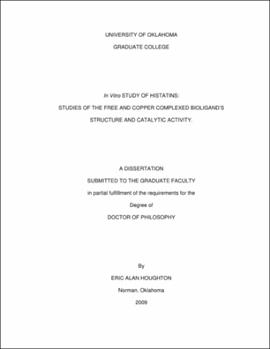| dc.contributor.advisor | Nicholas, Kenneth M. | |
| dc.creator | Houghton, Eric Alan | |
| dc.date.accessioned | 2019-04-27T21:26:40Z | |
| dc.date.available | 2019-04-27T21:26:40Z | |
| dc.date.issued | 2009 | |
| dc.identifier | 99199407102042 | |
| dc.identifier.uri | https://hdl.handle.net/11244/318712 | |
| dc.description.abstract | The ability of the histidine-rich peptides, histatin-5 (Hst-5) and -8 (Hst-8), to support the generation of reactive oxygen species (ROS) during the copper-catalyzed oxidation of ascorbate and cysteine has been evaluated. High levels of hydrogen peroxide (70-580 mol/mol Cu/hr) are produced by aqueous solutions containing Cu(II), Hst-8 or Hst-5, and a reductant, either ascorbate or cysteine, as determined by the post-reaction Amplex Red (AR) assay. When the reactions are conducted in the presence of superoxide dismutase (SOD), the total hydrogen peroxide produced is decreased, more so in the presence of the peptides (up to 50%), suggesting the intermediacy of superoxide in these reactions. On the other hand, the presence of sodium azide or sodium formate, traps for hydroxyl radicals, has no appreciable effect on the total hydrogen peroxide production for the Cu-Hst systems. Electron paramagnetic resonance (EPR) spectroscopy spin-trapping studies using CYPMPO (5-(2,2-dimethyl-1,3-propoxy cyclophosphoryl)-5-methyl-1-pyrroline N-oxide) in the cysteine/Cu(II) reactions reveal the formation of the CYPMO-hydroperoxyl and -hydroxyl radical adducts in the presence of Hst-8, whereas only the latter was observed with Cu alone. | |
| dc.description.abstract | As in vitro ROS production involved copper ions, the complex formation of the peptide-metal species was also of interest. The specific residues involved in coordinating the copper were investigated using nuclear magnetic resonance spectroscopy (NMR) experiments, specifically by 1H-15N heteronuclear multiple bond correlation (HMBC), heteronuclear single quantum correlation (HSQC), and 1H-13C HSQCAD experiments. Protonation of Hst-8 and model poly-imidazole ligands resulted in distinct downfield shifts of proton, carbon and nitrogen resonances of the imidazolyl units. Tight binding metal complexes of model compounds were also observed to have downfield resonance shifts upon binding Cu(I). Unfortunately, Hst-8 does not bind copper tightly enough to permit observations of downfield shifted peaks. Peaks were instead observed to be broadened and in some cases absent. However, because these were localized to only certain residues, assignments were made on the basis of which resonances exhibited such behavior. This evidence in addition to computational results led to the conclusion that residues histidine 3, histidine 6, and histidine 7 are involved in the binding of Cu(I) in Hst-8 at a 1:1 Cu(I):Hst-8 ratio of concentration in DMSO. | |
| dc.description.abstract | The conformational structure of Hst-8 in DMSO, both in the presence and absence of a copper (I) ion, has also been investigated using NMR experiments. The Nuclear Overhauser Effect (NOE), which is a nuclear spin transfer through space, was used in experimental series to identify protons in nearby space. This was useful in determining the larger three dimensional picture of the peptide in solution when the identities of the proton resonances were identified via total correlation spectroscopy (TOCSY) and 1H-13C HSQC experiments. After the spatial contacts were identified, boundary restriction data was generated by MARDIGRAS and the restriction data was input into a molecular dynamics (MD) simulator CNS, which output the structure. We found that Hst-8 did not have either beta strand or alpha helical secondary structural elements, in DMSO either as a free ligand or in the presence of Cu(I). | |
| dc.format.extent | 242 pages | |
| dc.format.medium | application.pdf | |
| dc.language | en_US | |
| dc.relation.requires | Adobe Acrobat Reader | |
| dc.subject | Peptides | |
| dc.subject | Copper enzymes | |
| dc.subject | Active oxygen | |
| dc.subject | Ligands (Biochemistry) | |
| dc.title | In Vitro Study of Histatins: Studies of the Free and Copper Complexed Bioligand's Structure and Catalytic Activity. | |
| dc.type | text | |
| dc.type | document | |
| dc.thesis.degree | Ph.D. | |
| ou.group | College of Arts and Sciences::Department of Chemistry and Biochemistry | |
